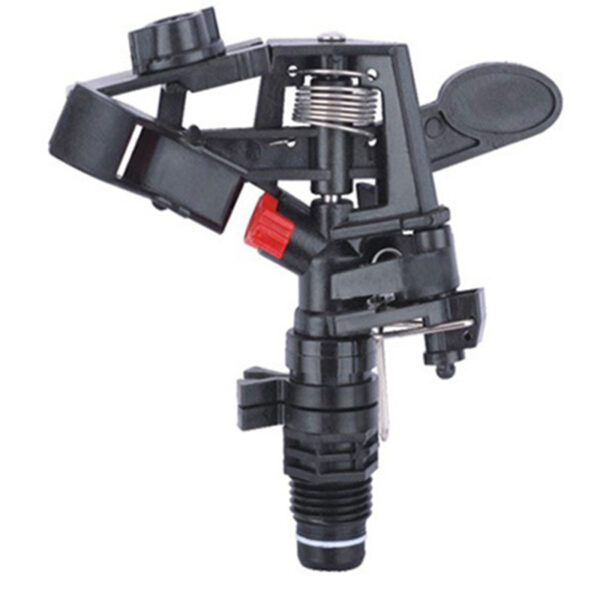The coverage area of a plastic impact sprinkler directly affects its performance in terms of water distribution and irrigation efficiency.
Here’s how the coverage area impacts the sprinkler’s performance:
Water Distribution: The coverage area determines the extent to which the sprinkler can distribute water over a given area. A larger coverage area means the sprinkler can reach a wider radius, covering more ground with each rotation. This is beneficial for efficiently irrigating larger areas.
Uniformity of Water Distribution: The coverage area influences the uniformity of water distribution. Ideally, a sprinkler should deliver water evenly across the entire coverage area. If the coverage area is too small, there may be gaps or uneven watering, resulting in dry spots. Conversely, if the coverage area is too large, there can be overlapping water patterns leading to excessive water use and potential water wastage.
Overlapping Coverage: When multiple sprinklers are used in a system, the coverage areas should overlap to ensure consistent water distribution. The size of the coverage area determines the spacing between sprinklers to achieve the desired overlap. Proper overlap ensures that each area receives sufficient water, minimizing dry spots and optimizing irrigation efficiency.
Water Pressure and Flow Rate: The coverage area can affect the water pressure and flow rate required for optimal performance. As the coverage area increases, the water pressure and flow rate need to be adjusted to maintain adequate water distribution. If the coverage area is too large for the water pressure available, the sprinkler’s performance may be compromised, leading to insufficient water coverage and reduced irrigation effectiveness.
Irrigation System Design: The coverage area of a plastic impact sprinkler is a crucial factor in the overall design of an irrigation system. It determines the spacing and layout of the sprinklers to ensure complete coverage and efficient water use. The design should consider factors such as water pressure, flow rate, and the specific requirements of the area being irrigated.
Water Conservation: By selecting a plastic impact sprinkler with an appropriate coverage area, water conservation can be achieved. A properly sized coverage area ensures that water is distributed only where needed, avoiding overspray onto non-targeted areas. This minimizes water waste and promotes efficient water management.
It’s important to note that the coverage area of a plastic impact sprinkler should be selected based on the specific requirements of the area to be irrigated. Factors such as the size and shape of the area, water availability, and plant water needs should be considered to ensure optimal performance and efficient water usage.
How do plastic impact sprinklers distribute water in an irrigation system?
Plastic impact sprinklers distribute water in an irrigation system using a combination of mechanical impact and rotational movement. Here’s how the process typically works:
Water Supply: The plastic impact sprinkler is connected to a water supply line, plastic impact sprinkler such as a main water pipe or lateral line, which provides pressurized water to the sprinkler.
Nozzle and Arm Assembly: The sprinkler head consists of a nozzle and an arm assembly. The nozzle determines the flow rate and spray pattern, while the arm assembly controls the rotational movement of the sprinkler.
Impact Mechanism: Inside the sprinkler head, there is an impact mechanism that includes a spring-loaded arm and a trip pin. When water flows through the sprinkler, it enters the impact mechanism.
Rotational Movement: The force of the flowing water hits the trip pin, causing the arm to move and rotate. This rotational movement is typically driven by the impact force generated by the water hitting the arm.
Water Distribution: As the sprinkler rotates, it distributes water in a circular or semi-circular pattern. The nozzle determines the specific spray pattern, which can vary from a full circle (360 degrees) to a part circle (e.g., 90 degrees, 180 degrees).
Water Distance and Coverage: The distance and coverage area of the water spray depend on several factors, including the water pressure, nozzle size, and design of the sprinkler. These factors are selected based on the specific requirements of the area being irrigated.
Overlapping Coverage: In larger irrigation systems, multiple plastic impact sprinklers are often used in conjunction with each other to achieve complete coverage. The coverage areas of adjacent sprinklers are typically designed to overlap, ensuring that no areas are missed and providing uniform water distribution.
Adjustable Features: Many plastic impact sprinklers offer adjustable features, such as adjustable nozzles or diffusers, which allow users to customize the spray pattern, radius, and flow rate to meet the specific needs of the irrigation area.
Water Pressure Considerations: The performance of plastic impact sprinklers is influenced by water pressure. Adequate water pressure is required to generate the necessary impact force for the rotational movement and to achieve the desired coverage distance and pattern.
Automatic Shut-off: Some plastic impact sprinklers may include an automatic shut-off mechanism that stops water flow when the sprinkler reaches its original starting position. This prevents excessive water usage and ensures water is directed only where it is needed.
Plastic impact sprinklers are widely used in various irrigation applications due to their durability, affordability, and versatility in water distribution. Their mechanical impact and rotational movement mechanism make them effective in providing water to lawns, gardens, agricultural fields, and other irrigation areas.
